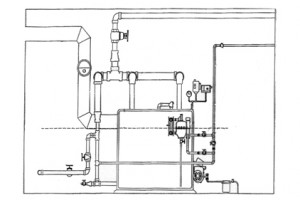We always have turkey for Thanksgiving. I mean who doesn’t? My job wasn’t to cook it, though; it was to eat it.
Reasons Why the System is Producing Unwanted Vacuum, and Where to Look for Solutions
There are sags in the mains between the boiler and the main vents.
Sags in the main give condensate a place to lay. This creates water hammer when the system starts again, but it can also create vacuum when the boiler shuts off. At very low pressure, steam takes up about 1,700 times the space of water. That's why it doesn't take much water to fill a system with steam. But when the steam condenses, it turns back into water, shrinking in volume about 1,700 times. If air can't get in to take the place of the shrinking steam, vacuum will form.
If there's a sag in the main that fills with condensate, it may be enough to stop the air from reentering the system. If the vacuum is deep enough, it can make the water in the boiler surge up and down. Check the pitch of the pipes with a line level.
The steam pipes are partially insulated.
You're supposed to insulate the supply pipes in a steam system so the steam doesn't condense on its way to the radiators. If some insulation is missing, the steam may be condensing quickly in some areas, and slowly in others. This can create pockets of vacuum within the system, which will cause the steam to flow unevenly.
Insulate all the steam pipes.
There are motorized zone valves near the header.
If a motorized valve in the header piping closes while the boiler is steaming, the steam can't get out of the boiler. When the burner shuts off, the steam that's trapped between the motorized valve and the boiler water line will condense. That condensing action forms a deep vacuum within the boiler. If there's a boiler-feed pump serving the boiler, the vacuum will draw water in from the receiver and flood the boiler.
Install a vacuum breaker in the boiler or the near-boiler piping. Make sure you pipe the vacuum breaker between the boiler water line and the motorized valve.
There are vacuum-type air vents in the system.
In the days of coal-fired boilers, the Dead Men used special air vents that had check valves at their outlets. The check valves let the air out, but they wouldn't let it back in. As a system ran, and the steam condensed, a natural vacuum formed.
The Dead Men used that vacuum to their advantage because in a vacuum, water will boil at a lower temperature. As the coal pile burned down, the energy entering the water lessened. But since the system was in a vacuum, the boiler could still make steam, although it had less fire to work with.
This type of vacuum vent does not work well in an oil- or gas-fired system, however, because the vacuum forms too quickly. Air that can't make its way out on the first cycle will expand greatly and block the flow of the steam to parts of the system.
If you run into this type of vacuum-inducing air vent, replace it with a standard air vent.
Want more troubleshooting tips? Check out A Pocketful of Steam Problems (With Solutions!).
Leave a comment
Related Posts
I had written a story for Plumbing & Mechanical a while back about a fella in Canada who sent me this email: "Our problem is that five out of hundreds of univentilator co...

I love all the advances taking place in the world of hydronics, but I’m still seeing plenty of steam systems out there in our older cities, so knowing about dry steam wil...